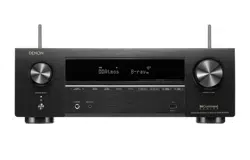Documents: Go to download!
- User Manual - (English, French, Spanish)
- User Manual - (French)
- User Manual - (Spanish)
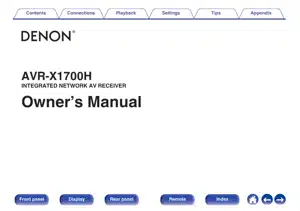
Owner’s ManualNETWORK AV RECEIVER
Part names and functions
Front panel



Display

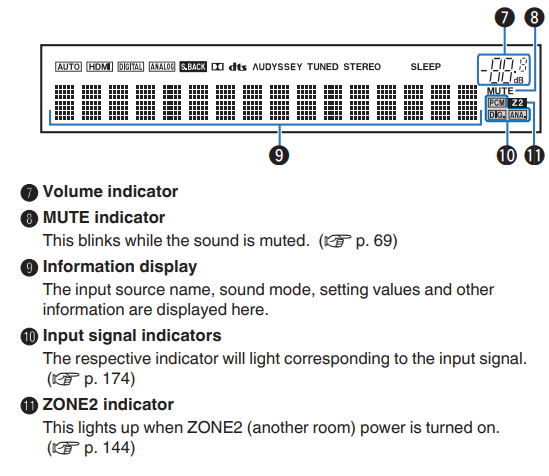
Rear panel
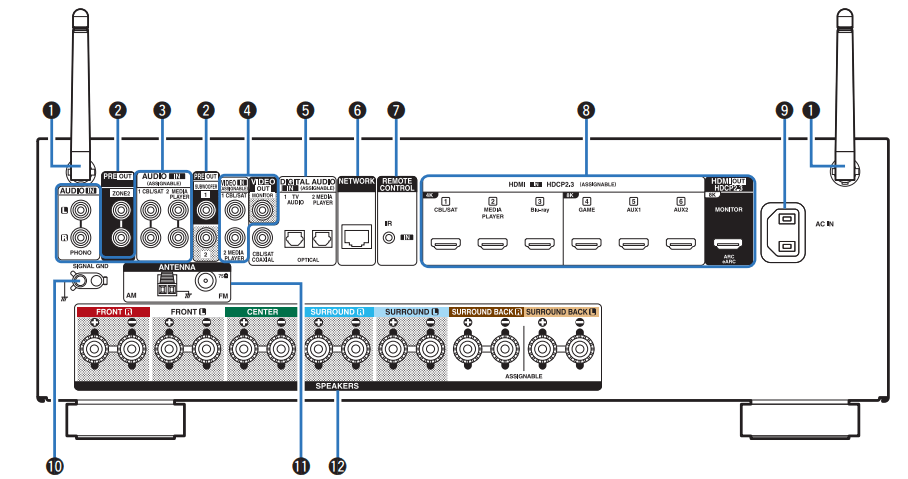
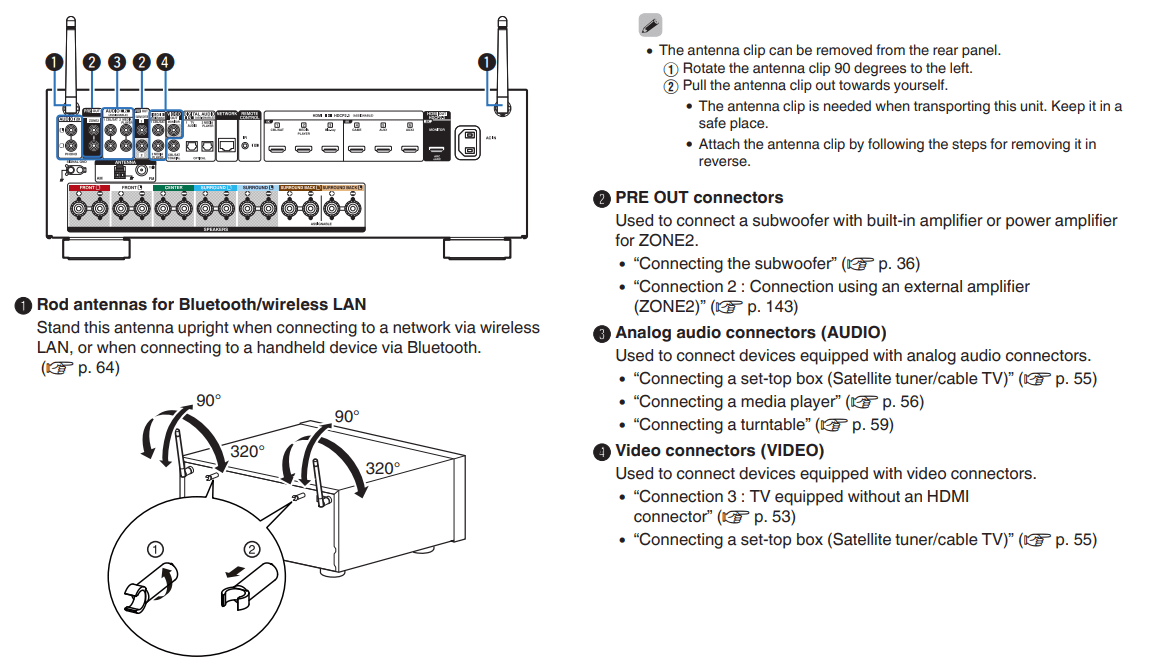
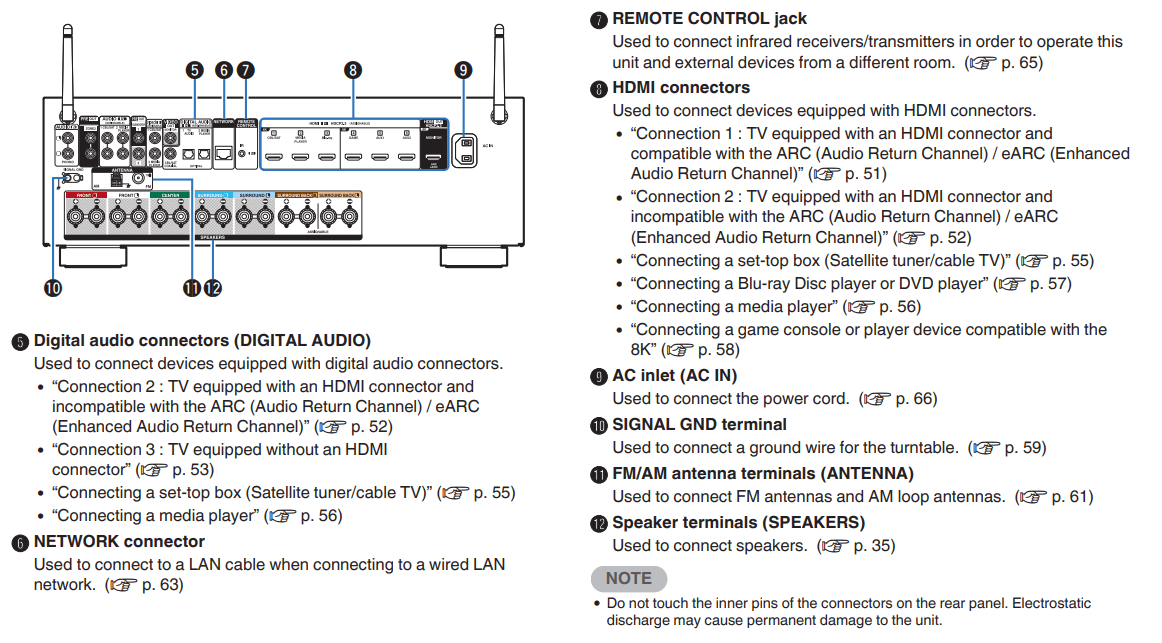
Remote control unit
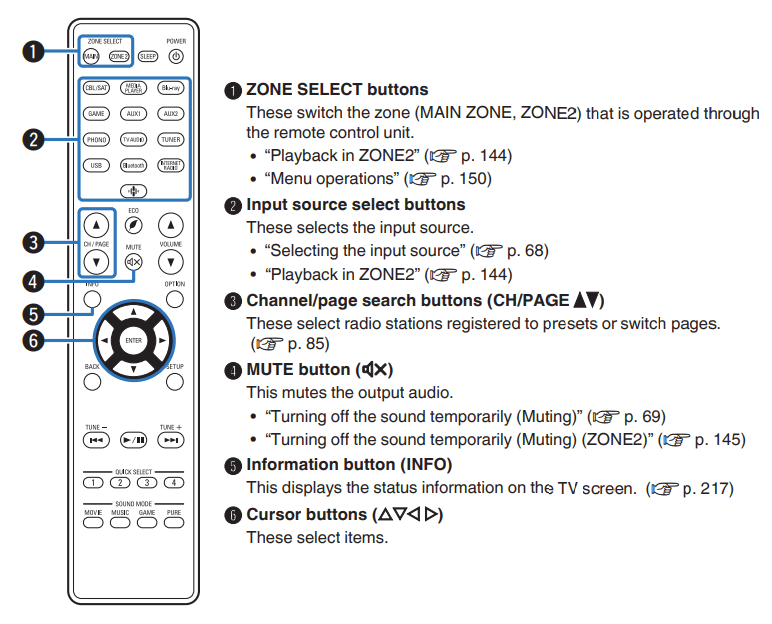

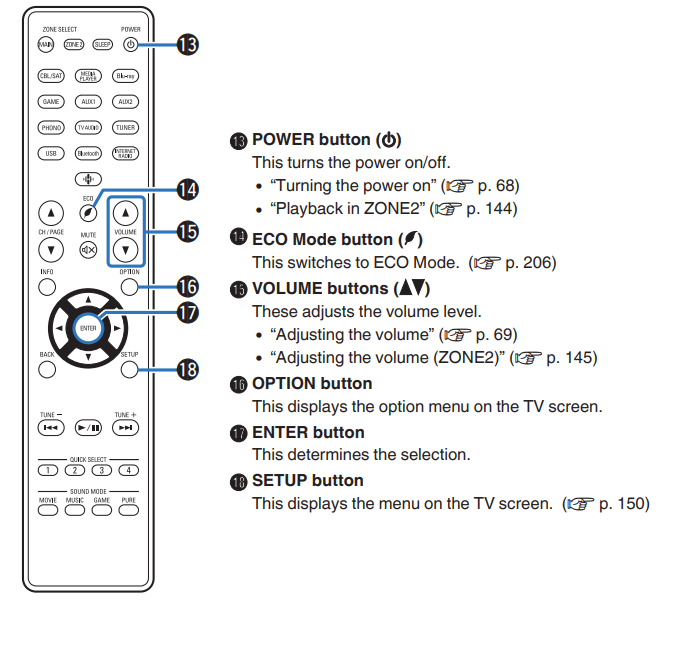
Connections
Cables used for connections
Provide necessary cables according to the devices you want to connect.

Connecting a TV
Connect a TV to this unit so that the input video is output to the TV. You can also enjoy audio from the TV on this unit. How to connect a TV depends on the connectors and functions equipped on the TV. ARC (Audio Return Channel) / eARC (Enhanced Audio Return Channel) function plays TV audio on this unit by sending the TV audio signal to this unit via HDMI cable.

Connection 1 : TV equipped with an HDMI connector and compatible with the ARC (Audio Return Channel) / eARC (Enhanced Audio Return Channel)
Use an HDMI cable to connect a TV that is compatible with the ARC / eARC function to this unit. Set “HDMI Control” to “On” or “ARC” to “On” when using a TV that supports the ARC function. (p. 165) Using an eARC function-compatible television enables audio playback from the speaker connected to this unit, regardless of “HDMI Control” and “ARC” settings in the menu.

- eARC function settings may be required depending on the eARC function-compatible television you are using. Make sure eARC is set to on if this setting exists on your television. For more information, check your television’s owner’s manual.
- When an ARC and eARC function-compatible television is connected, the eARC function is prioritized.
- Use a “High Speed HDMI Cable with Ethernet” when using an ARC / eARC function-compatible television.
- Use a certified “Ultra High Speed HDMI cable” to enjoy 8K or 4K 120Hz video.
- Set “4K/8K Signal Format” to “8K Enhanced” in the menu to enjoy 8K video. (
 p. 169)
p. 169)
Connection 2 : TV equipped with an HDMI connector and incompatible with the ARC (Audio Return Channel) / eARC (Enhanced Audio Return Channel)
Use an HDMI cable to connect the TV to this unit. To listen to audio from TV on this unit, use an optical cable to connect the TV to this unit

Connection 3 : TV equipped without an HDMI connector
Use a video cable to connect the TV to this unit. To listen to audio from TV on this unit, use an optical cable to connect the TV to this unit.
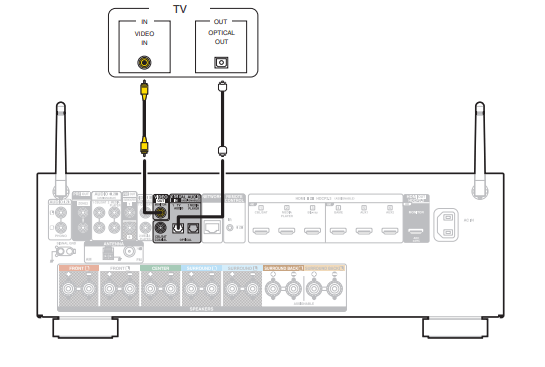
Connecting FM/AM antennas
Connect the antenna, tune in to a broadcast and then move the antenna to the location where there is least noise. Then use tape, etc. to fix the antenna in this location. (“Listening to FM/AM broadcasts” ( p. 81))
p. 81))
 If you are unable to receive a good broadcast signal, we recommend installing an outdoor antenna. For details, inquire at the retail store where you purchased the unit.
If you are unable to receive a good broadcast signal, we recommend installing an outdoor antenna. For details, inquire at the retail store where you purchased the unit.
NOTE Make sure the AM loop antenna lead terminals do not touch metal parts of the panel.

Using the AM loop antenna
Suspending on a wall
Suspend directly on a wall without assembling.
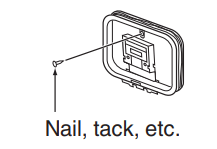
Standing alone
Use the procedure shown above to assemble.
When assembling, refer to “AM loop antenna assembly”.
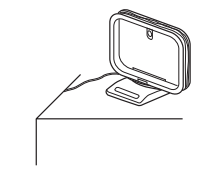
AM loop antenna assembly
- Put the stand section through the bottom of the loop antenna from the rear and bend it forward.
- Insert the projecting part into the square hole in the stand.

Connecting to a home network (LAN)
This unit can connect to a network using a wired LAN or wireless LAN.
You can connect this unit to your home network (LAN) to enable various types of playback and operations as described below.
- Playback of network audio such as Internet Radio and from your media server(s)
- Playback of streaming music services
- Using the Apple AirPlay function
- Operation on this unit via the network
- Operation with the HEOS wireless multi-room sound system
- Firmware Update
For connections to the Internet, contact an ISP (Internet Service Provider) or a computer shop.
Wired LAN
To make connections via wired LAN, use a LAN cable to connect the router to this unit as shown in the figure below.

Wireless LAN
When connecting to a wireless LAN network, stand the rod antenna for
Bluetooth/wireless LAN connection upright on the rear panel.
See “Wi-Fi Setup” on how to connect to a wireless LAN router. ( p. 199)
p. 199)
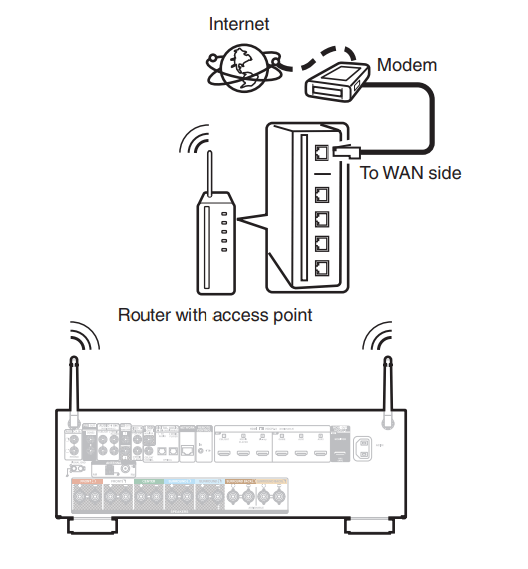

- When using this unit, we recommend you use a router equipped with the following functions:
- Built-in DHCP server
This function automatically assigns IP addresses on the LAN. - Built-in 100BASE-TX switch
When connecting multiple devices, we recommend a switching hub with a speed of 100 Mbps or greater.
- Built-in DHCP server
- Only use a shielded STP or ScTP LAN cable (readily available at electronics stores). (CAT-5 or greater recommended)
- The normal shielded-type LAN cable is recommended.
If a flat-type cable or unshielded-type cable is used, other devices could be affected by noise. - When using this unit connected to a network with no DHCP function, configure the IP address, etc. in “Network”. (
 p. 198)
p. 198)
NOTE
- The types of routers that can be used depend on the ISP. Contact your ISP or a computer shop for details.
- This unit is not compatible with PPPoE. A PPPoE compatible router is required if your contracted line is not set using PPPoE.
- Do not connect a NETWORK connector directly to the LAN port / Ethernet connector on your computer.
- Various online services may be discontinued without prior notice.
Connecting an external control device
REMOTE CONTROL jacks
When this unit is installed in a location where the remote control signals cannot reach (installation in a cabinet etc.), it can still be controlled by the remote control by connecting a remote control receiver unit (sold separately).
You can also use it to remotely control ZONE2 (another room).
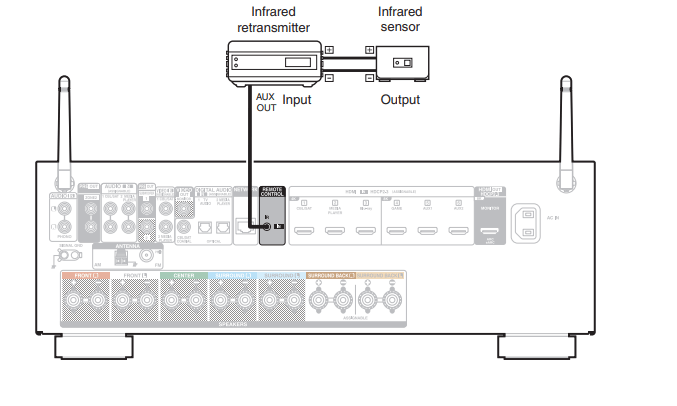
Basic operation

Turning the power on
 Press POWER
Press POWER  to turn on power to the unit.
to turn on power to the unit.
- You can press the input source select button when the unit is in standby mode to turn on the power.
- You can also switch the power to standby by pressing X on the main unit.
Selecting the input source
 Press the input source select button to be played back.
Press the input source select button to be played back.
The desired input source can be selected directly.
- You can also select the input source by turning SOURCE SELECT on the main unit.
Playing a USB memory device
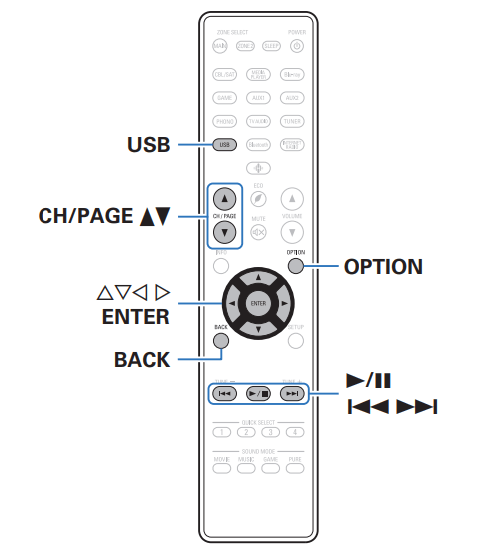
- Playing back music files stored on a USB memory device.
- Only USB memory devices conforming to mass storage class standards can be played on this unit.
- This unit is compatible with USB memory devices in “FAT32” or “NTFS” format.
- The audio format types and specifications supported by this unit for playback are as follows.
See “Playing back a USB memory devices” (p. 252) for details. - WMA
- MP3
- WAV
- MPEG-4 AAC
- FLAC
- Apple Lossless
- DSD
Playing files stored on USB memory devices
- Insert a “FAT32” or “NTFS” formatted USB memory device into the USB port.
- Press USB to switch the input source to “USB”.
- Select the name of this unit.
- Browse the music on your USB memory device and select something to play.
- When you select something to play you will be asked how you want to queue up your music

- When you select something to play you will be asked how you want to queue up your music
- Use
 to select the “Play Now” or “Play Now & Replace Queue”, then press ENTER. Playback starts.
to select the “Play Now” or “Play Now & Replace Queue”, then press ENTER. Playback starts.


- When an MP3 music file includes album art data, the album art can be displayed while playing the file.
NOTE
- Note that Denon will accept no responsibility whatsoever for any problems arising with the data on a USB memory device when using this unit in conjunction with the USB memory device.
- When a USB memory device is connected to this unit, the unit loads all of the files on the USB memory device. Loading may take a while if the USB memory device contains a large number of folders and/or files.
Listening to music on a Bluetooth device
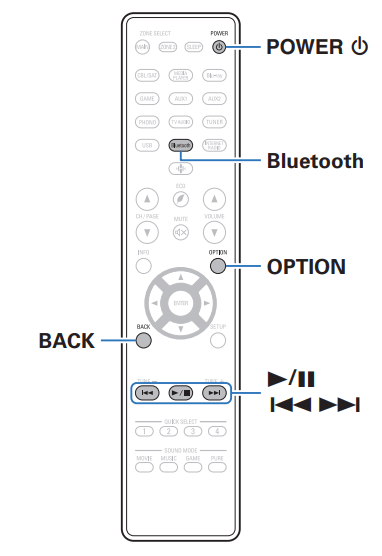
Music files stored on Bluetooth devices such as smartphones, digital music players, etc. can be enjoyed on this unit by pairing and connecting this unit with the Bluetooth device. Communication is possible up to a range of about 98.4 ft/30 m.
NOTE :To play back music from a
Playing music from Bluetooth device
In order to enjoy music from a Bluetooth device on this unit, the Bluetooth device must first be paired with this unit.
Once the Bluetooth device has been paired, it does not need to be paired again.
 Press POWER
Press POWER  to turn on power to the unit.
to turn on power to the unit.
 Press Bluetooth.
Press Bluetooth.
When using for the first time, the unit will go into the pairing mode automatically and “Pairing...” will appear on the display of the unit.
 Activate the Bluetooth settings on your mobile device.
Activate the Bluetooth settings on your mobile device.
 Select this unit when its name appears in the list of devices displayed on the screen of the Bluetooth device.
Select this unit when its name appears in the list of devices displayed on the screen of the Bluetooth device.
Connect to the Bluetooth device while “Pairing” is being displayed on the display of the unit.
Perform the connection with the Bluetooth device close to the unit about 3.3 ft/1 m).
 Play music using any app on your Bluetooth device.
Play music using any app on your Bluetooth device.
- The Bluetooth device can also be operated with the remote control of this unit.
- The next time the Bluetooth button is pressed on the remote control unit, this unit automatically connects to the last Bluetooth device that was connected.

- Press STATUS on this unit during playback to switch the display between Title name, Artist name, Album name, etc.
Pairing with other Bluetooth devices
Pair a Bluetooth device with this unit.
 Activate the Bluetooth settings on your mobile device.
Activate the Bluetooth settings on your mobile device.
 Press and hold Bluetooth on the remote control unit for at least 3 seconds.
Press and hold Bluetooth on the remote control unit for at least 3 seconds.
This unit will go into the pairing mode.
 Select this unit when its name appears in the list of devices displayed on the screen of the Bluetooth device.
Select this unit when its name appears in the list of devices displayed on the screen of the Bluetooth device.
- This unit can be paired with a maximum of 8 Bluetooth devices. When a 9th Bluetooth device is paired, it will be registered in place of the oldest registered device.
- You can also enter pairing mode by pressing the OPTION button when the
Bluetooth playback screen is displayed and selecting “Pairing Mode” from the displayed option menu.
NOTE
- To operate the Bluetooth device with the remote control of this unit, the Bluetooth device needs to support the AVRCP profile.
- The remote control of this unit is not guaranteed to work with all Bluetooth devices.
- Depending on the type of Bluetooth device, this unit outputs audio that is coupled to the volume setting on the Bluetooth device.
Operations accessible through the option menu
- “Pairing with other Bluetooth devices” (
 p. 76)
p. 76) - “Adjusting the audibility of dialog and vocals (Dialog
- Enhancer)” (
 p. 110)
p. 110) - “Adjusting the volume of each channel to match the input source (Channel Level Adjust)” (
 p. 111)
p. 111) - “Adjusting the tone (Tone)” (
 p. 112)
p. 112) - “Adjusting audio delay (Audio Delay)” (
 p. 113)
p. 113) - “Displaying your desired video during audio playback (Video
- Select)” (
 p. 114)
p. 114) - “Playing the same music in all zones (All Zone Stereo)” (
 p. 115)
p. 115)
Reconnecting to this unit from a Bluetooth device
After pairing is completed, the Bluetooth device can be connected without performing any operations on this unit.
This operation also needs to be performed when switching the Bluetooth device for playback.
 If a Bluetooth device is currently connected, deactivate the Bluetooth setting of that device to disconnect it.
If a Bluetooth device is currently connected, deactivate the Bluetooth setting of that device to disconnect it.
 Activate the Bluetooth setting of the Bluetooth device to be connected.
Activate the Bluetooth setting of the Bluetooth device to be connected.
 Select this unit from the Bluetooth device list on your Bluetooth device.
Select this unit from the Bluetooth device list on your Bluetooth device.
 Play music using any app on your Bluetooth device.
Play music using any app on your Bluetooth device.
- The screen automatically switches to the “Bluetooth” playback screen if a Bluetooth device is connected while the power of this unit is on.
- When the “Network Control” setting of this unit is set to “Always On” and a Bluetooth device is connected with the unit in the standby state, the power of the unit will be turned on automatically. (p. 202)
Listening to audio on Bluetooth headphones
You can listen to audio playing through the MAIN ZONE of this unit on Bluetooth headphones. Output audio from connected speakers and Bluetooth headphones simultaneously, or only using Bluetooth headphones.
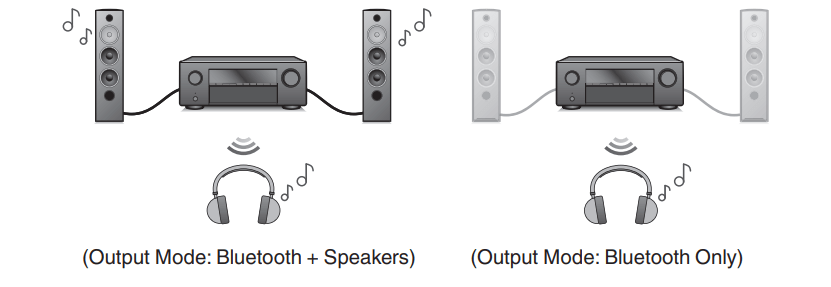
- Set “Transmitter” to “On” from the “General” - “Bluetooth Transmitter” setting in the menu.
- Select “Output Mode”, and set audio output method.

- Enter pairing mode on the Bluetooth headphones you want to connect to this unit.
- Select “Device List” and select the name of the Bluetooth headphones from the device list.
- Adjust the volume of connected Bluetooth headphones after the connection is completed.
- Output Mode” can also be set from “Bluetooth Transmitter” in the option menu.
- A2DP profile-compatible Bluetooth speakers can be connected following the same steps used to connect Bluetooth headphones.
NOTE
- Bluetooth headphones volume cannot be adjusted from this unit. Adjust volume of your Bluetooth headphones.
- Stereo mode is fixed as the sound mode when using Bluetooth headphones. Any sound modes and other audio settings are not reflected in audio output on Bluetooth headphones.
Audio settings, sound modes and All Zone Stereo mode are not available while using Bluetooth headphones and “Output Mode” is set to “Bluetooth Only”. - Audio may be delayed when sent over Bluetooth.
- Bluetooth headphones cannot be connected when use a Bluetooth input source in any zone.
Furthermore, selecting a Bluetooth input source in any zone will terminate the connection between this unit and Bluetooth headphones. - Bluetooth headphones cannot be connected when this unit is grouped in the HEOS App.
CAUTION:
Using Bluetooth headphones without a volume adjustment function
- In order to avoid hearing loss, do not connect Bluetooth headphones that lack volume adjustment functionality.
- Bluetooth headphone volume may be unexpectedly loud when this unit connects to Bluetooth headphones.
- Bluetooth headphone volume cannot be adjusted from this unit.
Reconnecting to a Bluetooth headphones
Follow any of the steps below to reconnect the most recently used Bluetooth headphones:
- Reconnect to this unit with Bluetooth headphone's reconnect function.
- Go to “Bluetooth Transmitter” and then select “Reconnect” within the options menu.
- If “Output Mode” is set to “Bluetooth + Speakers”, this unit will automatically connect to the most recently used Bluetooth headphones when power is turned on.
- Select the device you wish to connect from the “Device List” under "Bluetooth Transmitter” in the menu. (p. 210)
Disconnecting Bluetooth headphones
Complete any of the following steps to disconnect your Bluetooth headphones:
- Turn off your Bluetooth headphones.
- Go to “Bluetooth Transmitter” and then select “Disconnect” within the options menu.
- In the setup menu, go to “General” - “Bluetooth Transmitter”, and set “Transmitter” to Off. (p. 210)
Setting
Menu operations

 Press MAIN on the remote control unit to set the operating zone to the MAIN ZONE.
Press MAIN on the remote control unit to set the operating zone to the MAIN ZONE.
The MAIN button lights.
 Press SETUP.
Press SETUP.
The menu is displayed on the TV screen.
 Use
Use  to select the menu to be set or operated, then press ENTER.
to select the menu to be set or operated, then press ENTER.
 Use
Use  to change to desired setting.
to change to desired setting.
 Press ENTER to enter the setting.
Press ENTER to enter the setting.
To return to the previous item, press BACK.
Exiting the menu, press SETUP while the menu is displayed. The menu display disappears.
Error messages
An error message is displayed if Audyssey® Setup could not be completed due to speaker placement, the measurement environment, etc. If an error message is displayed, check the relevant items and perform the necessary measures. Be sure to turn off the power before checking speaker connections.
Examples | Error details | Measures |
No speakers found. |
|
|
Ambient noise is too high or level is too low |
|
|
Front R : None |
|
|
Front R : Phase |
|
|
Network
To use this unit by connecting it to a home network (LAN), you must configure network settings. If you set up your home network (LAN) via DHCP, set “DHCP” to “On”. (Use the default setting.) This allows this unit to use your home network (LAN). When assigning an IP address to each device manually, you need to assign an IP address to this unit using the “IP Address” settings, and enter information about your home network (LAN) such as the gateway address and subnet mask, etc.

Connection
Choose whether to connect the home network to a wireless LAN or a wired LAN. When connecting to the network using wired LAN, select “Wired(Ethernet)” after connecting a LAN cable. When connecting to the network using wireless LAN, select “Wireless(WiFi)” and configure the “Wi-Fi Setup”. ( p. 199)
Connect Using
Select the method for connecting to the home network (LAN).

General
Make various other settings.
Language
Set the language for display the menu on the TV screen. English / Français / Español (Default: English)
- Language” can also be set up by the following operation. However, the menu screen is not displayed. Watch the display while configuring the settings.
- Press and hold the main unit’s ZONE2 SOURCE and STATUS at the same time for at least 3 seconds.
"V.Format:< NTSC>” appears on the display. - Press DIMMER on the main unit twice.
- "Lang.:<ENGLISH >” appears on the display.
- Use the main unit’s TUNER PRESET CH + or TUNER PRESET CH – and set the language.
- Press the main unit’s STATUS to complete the setting.
ECO
Configure the ECO Mode and auto standby mode settings.
ECO Mode
This mode can reduce the power consumption and heat generation of this unit when power on.
This is done by reducing the power supply line to the power amplifier, in turn the maximum power output.

- When the unit is switching between the different power saving states in “ECO Mode: Auto”, you may notice a click noise from the inside of this unit, this is normal.
- If content is paused for more than 2 minutes and playback is resumed from the same source at these high volume levels, there may be short delay before maximum power is restored.
- "ECO Mode” can also be switched by pressing ECO G on the remote control unit.
Tips
I want the volume not to become too loud by mistake
- Set the volume upper limit for “Volume Limit” in the menu beforehand. This prevents children or others from increasing the volume too much by mistake. You can set this for each zone. (“Volume” (p. 157), “Volume Limit” (p. 211))
I want to keep the volume at the same level when I turn the power on
- By default, the volume setting when power was previously set to standby on this unit is applied at next power on with no change. To use a fixed volume level, set the volume level at power on for “Pow.On Volume” in the menu. You can set this for each zone. (“Volume” (p. 157), “Pow.On Volume” (p. 211))
I want to have the subwoofer always output audio
- Depending on the input signals and sound mode, the subwoofer may not output audio. When “Subwoofer Mode” in the menu is set to “LFE+Main”, you can have the subwoofer always output audio. (p. 196)
I want to make human voices in the movies clearer
- Select a setting that makes the dialog easier to hear in the option menu “Dialog Enhancer”. (p. 110)
I want to keep bass and clarity during playback at a lower volume level
- Set “Dynamic EQ” in the menu to “On”. This setting corrects the frequency characteristics to allow you to enjoy clear sound without the bass being lost even during playback at a lower volume level. (p. 159)
I want to automatically adjust the volume level difference in content such as TV and movies
- Set “Dynamic Volume” in the menu. Volume level changes (between quiet scenes and loud scenes) in TV shows or movies are automatically adjusted to your desired level. (p. 160)
I want to set the optimized listening environment after changing the configuration/position of the speakers or changing a speaker to a new one
- Perform Audyssey® Setup. This automatically makes the optimized speaker settings for the new listening environment. (p. 176)
I want to combine a desired video with the current music
- Set “Video Select” in the option menu to “On”. You can combine the current music with your desired video source from a Set-top Box or DVD, etc. while listening to music from the Tuner, Phono, HEOS Music, USB or Bluetooth. (p. 114)
I want to skip unused input sources
- Set unused input sources for “Hide Sources” in the menu. This allows you to skip unused input sources when turning the SOURCE SELECT knob on this unit. (p. 175)
I want to enjoy the same music in all zones at the home party, etc.
- Set “All Zone Stereo” in the option menu to “Start”. You can simultaneously play back music in another room (ZONE2) that is played back in MAIN ZONE. (p. 115)
Troubleshooting
If a problem should arise, first check the following:
- Are the connections correct?
- Is the set being operated as described in the owner’s manual?
- Are the other devices operating properly?
- If steps 1 to 3 above do not improve the problem, restarting the device may improve the problem.
Continue pressing the X button on the unit until “Restart” appears in the display, or remove and re-insert the power cord of the unit.
If this unit does not operate properly, check the corresponding symptoms in this section.
If the symptoms do not match any of those described here, consult your dealer as it could be due to a fault in this unit. In this case, disconnect the power immediately and contact the store where you purchased this unit.
Power does not turn on / Power is turned off
Power does not turn on.
- Check whether the power plug is correctly inserted into the power outlet. (p. 66)
Power automatically turns off.
- The sleep timer is set. Turn on the power again. (p. 131)
- “Auto Standby” is set. “Auto Standby” is triggered when there is no operation for a set amount of time. To disable “Auto Standby”, set “Auto Standby” on the menu to “Off”. (p. 209)
Power turns off and the power indicator flashes in red approx. every 2 seconds.
- The protection circuit has been activated due to a rise in temperature within this unit. Turn the power off, wait about an hour until this unit cools down sufficiently, and then turn the power on again. (p. 273)
- Please re-install this unit in a place having good ventilation.
Power turns off and the power indicator flashes in red approx. every 0.5 seconds.
- Check the speaker connections. The protection circuit may have been activated because speaker cable core wires came in contact with each other or a core wire was disconnected from the connector and came in contact with the rear panel of this unit. After unplugging the power cord, take corrective action such as firmly re-twisting the core wire or taking care of the connector, and then reconnect the wire. (p. 35)
- Turn down the volume and turn on the power again. (p. 68)
- This unit’s amplifier circuit has failed. Unplug the power cord and contact our customer service center.
Power does not turn off even when the power button is pressed, and the display shows “ZONE2 On”.
- The power supply of ZONE2 is turned to ON. To turn off the power supply of this unit (standby), press the ZONE2 ON/OFF on the main unit, or press the POWER
 button after pressing the ZONE2 button on the remote control unit to turn off the power supply of ZONE2.
button after pressing the ZONE2 button on the remote control unit to turn off the power supply of ZONE2.
Operations cannot be performed through the remote control unit
Operations cannot be performed through the remote control unit.
- Batteries are worn out. Replace with new batteries. (p. 9)
- Operate the remote control unit within a distance of about 23 ft/7 m from this unit and at an angle of within 30°. (p. 9)
- Remove any obstacle between this unit and the remote control unit.
- Insert the batteries in the proper direction, checking the q and w marks. (p. 9)
- The set’s remote control sensor is exposed to strong light (direct sunlight, inverter type fluorescent bulb light, etc.). Move the set to a place in which the remote control sensor will not be exposed to strong light.
- The operation target zone does not correspond to the zone setting specified on the remote control unit. Press the MAIN or ZONE2 button to select the operating zone of the remote control. (p. 150)
- When using a 3D video device, the remote control unit of this unit may not function due to effects of infrared communications between units (such as TV and glasses for 3D viewing). In this case, adjust the direction of units with the 3D communications function and their distance to ensure they do not affect operations from the remote control unit of this unit.
Display on this unit shows nothing
Display is off.
- Set “Dimmer” on the menu to something other than “Off”. (p. 212)
- When the sound mode is set to “Pure Direct”, the display is off. (p. 120)
No sound comes out
No sound comes out of speakers.
- Check the connections for all devices. (p. 35)
- Insert connection cables all the way in.
- Check that input connectors and output connectors are not reversely connected.
- Check cables for damage.
- Check that speaker cables are properly connected. Check that cable core wires come in contact with the metal part on speaker terminals. (p. 35)
- Securely tighten the speaker terminals. Check speaker terminals for looseness. (p. 35)
- Check that a proper input source is selected. (p. 68)
- Adjust the volume. (p. 69)
- Cancel the mute mode. (p. 69)
- Check the digital audio input connector setting. (p. 172)
- Check the digital audio output setting on the connected device. On some devices, the digital audio output is set to off by default.
- When a headphone is plugged into the PHONES jack on the main unit, sound is not output from the speaker terminal and SUBWOOFER connector.
- Audio is output to your Bluetooth headphones, but not to speakers or pre-outs when “Output Mode” set to “Bluetooth Only”. Change “Output Mode” to "Bluetooth + Speakers” to output audio from your Bluetooth headphones as well as your speakers or pre-outs. (p. 210)
No sound comes out when using the DVI-D connection.
- When this unit is connected to a device equipped with a DVI-D connector, no sound is output. Make a separate audio connection
Desired sound does not come out
The volume does not increase.
- The maximum volume is set too low. Set the maximum volume using “Limit” on the menu. (p. 157)
- Appropriate volume correction processing is performed according to the input audio format and settings, so the volume may not reach the upper limit.
The volume of Bluetooth headphones does not decrease.
- Bluetooth headphones volume cannot be adjusted from this unit. Use a Bluetooth headphones with volume adjustment.
No sound comes out with the HDMI connection.
- Check the connection of the HDMI connectors. (p. 51)
- When outputting HDMI audio from the speakers, set “HDMI Audio Out” on the menu to “AVR”. To output from the TV, set “TV”. (p. 163)
- When using the HDMI Control function, check that the audio output is set to the AV amplifier on the TV. (p. 130)
When an eARC function-compatible television is connected, television audio is not output from the speaker connected to this unit
- eARC function settings may be required depending on the eARC function-compatible television you are using. Make sure eARC is set to on if this setting exists on your television. For more information, check your television’s owner’s manual.
- Make sure the input source of this unit is “TV Audio”.
- The eARC function does not operate when the HDMI input connector is set to the “TV Audio” input source. To enable eARC function operation, remove the HDMI input connector setting, then restart this unit and the television. (p. 173)
No sound comes out of a specific speaker.
- Check that speaker cables are properly connected.
- Check that a selection other than “None” is set for the “Speaker Config.” setting in menu. (p. 188)
- Check the “Assign Mode” setting in the menu. (p. 187)
- When the sound mode is “Stereo” and “Virtual”, audio is only output from the front speakers and subwoofer.
- Audio is not output from the surround back speaker if “Sp.Virtualizer” is set to “On” when “Speaker Config.” - “Surround Back” is set to “1 spkr” in the menu. (p. 154)
No sound is produced from subwoofer.
Check the subwoofer connections.
Turn on the subwoofer’s power.
- Set “Speaker Config.” – “Subwoofer” on the menu to “Yes”. (p. 189)
- When “Speaker Config.” - “Front” in the menu is set to “Large”, depending on the input signal and the sound mode, no sound may be output from the subwoofer. (p. 188)
- When no subwoofer audio signal (LFE) is included in the input signals, no sound may be output from the subwoofer. (p. 196)
- You can make the subwoofer always output sound by setting the “Subwoofer Mode” to “LFE+Main”. (p. 196)
DTS sound is not output.
- Check that the digital audio output setting on the connected device is set to “DTS”.
Dolby Atmos, Dolby TrueHD, DTS-HD, Dolby Digital Plus audio is not output.
- Make HDMI connections. (p. 55)
- Check the digital audio output setting on the connected device. On some devices, “PCM” is set by default.
DTS Neural:X mode cannot be selected.
- DTS Neural:X cannot be selected when using the headphones.
Dolby Surround mode cannot be selected.
- Dolby Surround cannot be selected when using the headphones.
Sound modes other than “Stereo” or “Direct” cannot be selected.
- Only “Stereo” or “Direct” can be selected for the sound mode if Headphone:X signals are input.
Audyssey MultEQ® XT, Audyssey Dynamic EQ® and Audyssey Dynamic Volume® cannot be selected.
- These cannot be selected when you have not performed Audyssey® Setup. (p. 176)
- Switch to a sound mode other than “Direct” or “Pure Direct”. (p. 119)
- These cannot be selected when sound mode is “DTS Virtual:X” or sound mode that have “+Virtual:X” in the sound mode name.
- These cannot be selected when using the headphones.
"Restorer” cannot be selected.
- Check that an analog signal or PCM signal (Sample Rate = 44.1/48 kHz) is input. For playback of multichannel signals such as Dolby Digital or DTS surround, “Restorer” cannot be used. (p. 156)
- Switch to a sound mode other than “Direct” or “Pure Direct”. (p. 119)
No sound is output when using ZONE2.
- Digital signal audio input from the HDMI connector or digital audio connectors (OPTICAL/COAXIAL) cannot be played back. Use analog connections.
- When listening to audio from a Bluetooth device in ZONE2, remove any obstructions between the Bluetooth device and this unit and use it within a range of about 98.4 ft/30 m.
Sound mode settings are not available when using Bluetooth headphones. Audio menu settings are also not available.
- This unit cannot change sound mode or audio menu settings for audio output to Bluetooth headphones.
Sound is interrupted or noise occurs
During playback from the Internet radio or USB memory device, sound is occasionally interrupted.
- When the transfer speed of the USB memory device is slow, sound may occasionally be interrupted.
- The network communication speed is slow or the radio station is busy.
When making a call on iPhone, noise occurs in audio output on this unit.
- When making a call, keep a distance of 0.7 ft/20 cm or longer between iPhone and this unit.
Noise often occurs in FM/AM broadcasting.
- Change the antenna orientation or position. (p. 61)
- Separate the AM loop antenna from the unit.
- Use an outdoor antenna. (p. 61)
- Separate the antenna from other connection cables. (p. 61)
The sounds appear to be distorted.
- Lower the volume. (p. 69)
- Set “Off” to the “ECO Mode”. When “On” or “Auto” is in the “ECO Mode”, the audio may by distorted when the playback volume is high. (p. 206)
Sound cuts out when using Wi-Fi connection.
- The frequency band used by the wireless LAN is also used by microwave ovens, cordless telephones, wireless game controllers and other wireless devices. Using such devices at the same time as this unit may cause sound to cut out due to electronic interference. Sound cut out can be improved using the following methods. (p. 63)
- Install devices that cause interference away from this unit.
- Turn off the power supply to devices that cause interference.
- Change the settings of the router channel to which this unit is connected to. (See the instruction manual of the wireless router for details on how to change the channel.)
- Switch to a wired LAN connection.
- Particularly when you play back large music files, depending on your wireless LAN environment, the playback sound may be interrupted. In this case, make the wired LAN connection. (p. 199)
No video is shown on the TV
No picture appears.
- Check the connections for all devices. (p. 51)
- Insert connection cables all the way in.
- Check that input connectors and output connectors are not reversely connected.
- Check cables for damage.
- Match the input settings to the input connector of the TV connected to this unit. (p. 172)
- Check that the proper input source is selected. (p. 68)
- Check the video input connector setting. (p. 172)
- Check that the resolution of the player corresponds to that of the TV. (p. 216)
- Check whether the TV is compatible with copyright protection (HDCP). If connected to a device not compatible with HDCP, video will not be output correctly. (p. 249)
- To enjoy content that is copyright protected by HDCP 2.2 or HDCP 2.3, use a playback device and TV compatible with HDCP 2.2 or HDCP 2.3.
- To play back a 4K video, use a “High Speed HDMI Cable” or an “High Speed HDMI Cable with Ethernet”. In order to achieve a higher fidelity for 4K videos, it is recommended to use a “Premium High Speed HDMI Cables” or an “Premium High Speed HDMI Cables with Ethernet” that has an HDMI Premium Certified Cable label on the product package.
- Use a certified “Ultra High Speed HDMI cable” to enjoy 8K or 4K 120Hz video. If you use a different HDMI cable, the video may not be displayed or other problems may occur.
No video is shown on the TV with the DVI-D connection.
- With the DVI-D connection, on some device combinations, devices may not function properly due to the copy guard copyright protection (HDCP). p. 249)
While the menu is being displayed, no video is shown on the TV.
- The video being played will not appear in the background of the menu when the menu is operated.
The menu screen is not displayed on the TV
The menu screen or status information screen is not displayed on the TV.
- The menu screen is only displayed on this unit and a TV connected with an HDMI cable. If this unit is connected to a TV using a different video output connector, operate while watching the display on this unit.
- The status information will not appear on the TV when the following video signals are being played.
- Some images of 3D video content
- Computer resolution images (example: VGA)
- Video with an aspect ratio other than 16:9 or 4:3
- Some kind of HDR signals
- Some kind of game contents
- Compressed video
- When a 2D video is converted to a 3D video on the TV, the menu screen or status information screen is not displayed properly. (p. 217)
- In the pure direct playback mode, the menu screen or status information is not displayed. Switch to a sound mode other than the pure direct mode. p. 118)
- Set the “TV Format” setting in the menu to a selection that is appropriate for the TV. (p. 171)
The color of the menu screen and operations content displayed on the television is different from normal
The color of the menu screen and operations content displayed on the television is different.
- Performing operations on this unit during playback of a Dolby Vision signal may cause variance in the color display of the menu screen and operations content. This is a characteristic of the Dolby Vision signal and is not a malfunction.
AirPlay cannot be played back
The AirPlay icon is not displayed on iTunes / iPhone / iPod touch / iPad.
- This unit and PC / iPhone / iPod touch / iPad are not connected to the same network (LAN). Connect it to the same LAN as this unit. (p. 63)
- The firmware on iTunes / iPhone / iPod touch / iPad is not compatible with AirPlay. Update the firmware to the latest version.
Audio is not output.
- The volume on iTunes / iPhone / iPod touch / iPad is set to the minimum level. The volume on iTunes / iPhone / iPod touch / iPad is linked with the volume on this unit. Set a proper volume level.
- The AirPlay playback is not performed, or this unit is not selected. Click the AirPlay icon on the iTunes / iPhone / iPod touch / iPad screen and select this unit. (p. 105)
Audio is interrupted during the AirPlay playback on iPhone / iPod touch / iPad.
- Quit the application running in the background of the iPhone/iPod touch/iPad, and then play using AirPlay.
- Some external factors may be affecting the wireless connection. Modify the network environment by taking measures such as shortening the distance from the wireless LAN access point.
iTunes cannot be played back through the remote control unit.
- Enable the “Allow iTunes audio control from remote speakers” setting on iTunes. Then, you can perform playback, pause, and skip operations through the remote control unit.
USB memory devices cannot be played back
USB memory device is not recognized.
- Disconnect and reconnect the USB memory device. (p. 60)
- Mass storage class compatible USB memory devices are supported.
- This unit does not support a connection through a USB hub. Connect the USB memory device directly to the USB port.
- The USB memory device must be formatted to “FAT32” or “NTFS”.
- Not all USB memory devices are guaranteed to work. Some USB memory devices are not recognized. When using a type of portable hard disc drive compatible with the USB connection that requires power from an AC adapter, use the AC adapter that came with the drive.
Files on the USB memory device are not displayed.
- Files of a type not supported by this unit are not displayed. (p. 70)
- This unit is able to display files in a maximum of eight folder layers. A maximum of 5000 files (folders) can also be displayed for each layer. Modify the folder structure of the USB memory device.
- When multiple partitions exist on the USB memory device, only files on the first partition are displayed. iOS and Android devices are not recognized.
The USB port of this unit does not support playback from iOS and Android devices.
Files on a USB memory device cannot be played.
- Files are created in a format that is not supported by this unit. Check the formats supported by this unit. (p. 252)
- You are attempting to play a file that is copyright protected. Files that are copyright protected cannot be played on this unit.
- Playback may not be possible if the album art file size exceeds 2 MB.
Bluetooth cannot be played back
Bluetooth devices cannot be connected to this unit.
- The Bluetooth function in the Bluetooth device has not been enabled. See the Owner’s Manual of the Bluetooth device to enable the Bluetooth function.
- Bring the Bluetooth device near to this unit.
- The Bluetooth device cannot connect with this unit if it is not compatible with the A2DP profile.
- Turn the power of the Bluetooth device off and on again, and then try again.
Smartphones and other Bluetooth devices cannot be connected.
- Smartphones and other Bluetooth devices cannot be connected when “Transmitter” is set to “On”. Press Bluetooth on the remote control to switch the input source to Bluetooth, then connect the device. (p. 210)
Cannot connect Bluetooth headphones.
- Bring the Bluetooth headphones near to this unit.
- Turn the power of the Bluetooth headphones off and on again, and then try again.
- Go to “General” - “Bluetooth Transmitter”, and set “Transmitter” to “On” within the menu. (p. 210)
- Make sure this unit is not already connected to another pair of Bluetooth headphones. Check the currently connected Bluetooth headphones by pressing INFO on the remote control or STATUS button on the unit.
Disconnect the connected Bluetooth headphones before connecting the ones you want to use. - Bluetooth headphones cannot be connected if Bluetooth is being used as an input source in any zone.
- Bluetooth headphones cannot be connected if this unit is grouped in the HEOS App. Remove this unit from the group to enable Bluetooth headphones connection.
- The Bluetooth headphones cannot connect with this unit if it is not compatible with the A2DP profile.
- Connection and operation are not guaranteed for all Bluetooth-enabled devices.
- This unit can only connect to one Bluetooth headphone at a time. However, up to 8 Bluetooth headphones can be registered. You can switch between registered devices from “Device List” in the “Bluetooth Transmitter” menu. (p. 210)
The sound is cut off.
- Bring the Bluetooth device near to this unit.
- Remove obstructions between the Bluetooth device and this unit.
- To prevent electromagnetic interference, locate this unit away from microwave ovens, wireless LAN devices and other Bluetooth devices.
- Reconnect the Bluetooth device.
The sound is cut off or noise occurs when using Bluetooth headphones.
- Move the Bluetooth headphones closer to this unit.
- Remove obstructions between the Bluetooth headphones and this unit.
- Reconnect the Bluetooth headphones.
- To prevent electromagnetic interference, locate this unit away from microwave ovens, wireless LAN devices and other Bluetooth devices.
- We recommend using wired LAN to connect this unit and other devices.
- Bluetooth transmits on the 2.4 GHz band which may interfere with Wi-Fi transmitted on this band. Connect this unit and other devices to Wi-Fi network on a 5 GHz band if available on your Wi-Fi router.
Audio is delayed on my Bluetooth headphones.
- This unit cannot adjust audio delay on Bluetooth headphones.
The Internet radio cannot be played back
A list of broadcasting stations is not displayed.
- The LAN cable is not properly connected, or the network is disconnected. Check the connection status. (p. 63)
- Perform the network diagnostic mode.
Internet Radio cannot be played.
- The selected radio station is broadcasting in a format that is not supported by this unit. Formats that can be played back in this unit are MP3, WMA and AAC. (p. 255)
- The firewall function is enabled on the router. Check the firewall setting.
- The IP address is not properly set. (p. 200)
- Check the power of the router is on.
- To obtain the IP address automatically, enable the DHCP server function on the router. Also, set the DHCP setting to “On” on this unit. (p. 200)
- To obtain the IP address manually, set the IP address on this unit. (p. 200)
- Some radio stations broadcast silently during some time period. In this case, no audio is output. Wait for a while and select the same radio station, or select another radio station. (p. 90)
- The selected radio station is not in service. Select a radio station in service.
Cannot connect to favorite radio stations.
- Radio station is not currently in service. Register radio stations in service
Music files on PC or NAS cannot be played back
Files stored on a computer cannot be played.
- Files are stored in a non-compatible format. Record in a compatible format. (p. 254)
- Files that are copyright protected cannot be played on this unit.
- The USB port of this unit cannot be used for connection to a computer.
- Media sharing settings on the server or NAS do not allow this unit. Change the settings to allow this unit. For details, see the owner’s manual of the server or NAS.
Server is not found, or it is not possible to connect to the server.
- The computer’s or router’s firewall is activated. Check the computer’s or router’s firewall settings.
- Computer’s power is not turned on. Turn on the power.
- Server is not running. Launch the server.
- IP address of this unit is wrong. Check the IP address of this unit. (p. 198)
Music files on PC cannot be played back.
- Even if PC is connected to the USB port on this unit, music files on it cannot be played back. Connect PC to this unit through the network. (p. 63)
Files on PC or NAS are not displayed.
- Files of a type not supported by this unit are not displayed. (p. 254)
Music stored on a NAS cannot be played.
- If you use a NAS in conformity with the DLNA standard, enable the DLNA server function in the NAS setting.
- If you use a NAS that does not conform with the DLNA standard, play the music via a PC. Set Windows Media Player’s media sharing function and add NAS to the selected play folder.
- If connection is restricted, set audio equipment as the connection target.
Various online services cannot be played
Various online services cannot be played.
- The online service may have been discontinued.
The HDMI Control function does not work
The HDMI Control function does not work.
- Check that “HDMI Control” in the menu is set to “On”. (p. 165)
- You cannot operate devices that are not compatible with the HDMI Control function. In addition, depending on the connected device or the settings, the HDMI Control function may not work. In this case, operate the external device directly. (p. 130)
- Check that the HDMI Control function setting is enabled on all devices connected to this unit. (p. 130)
- When you make connection related changes such as connecting an additional HDMI device, the link operation settings may be initialized. Turn off this unit and devices connected via HDMI, and turn them on again. (p. 130)
Cannot connect to a wireless LAN network
Cannot connect to the network.
- The network name (SSID), password and encryption setting have not been set up correctly. Configure the network settings according to the setting details of this unit. (p. 200)
- Shorten the distance from the wireless LAN access point and remove any obstructions to improve access first before re-connecting again. Place the unit away from microwave ovens and other network access points.
- Configure the access point channel settings away from channels that are being used by other networks.
- This unit is not compatible with WEP (TSN).
Cannot connect to a WPS Router.
- Check that the WPS mode of the router is operating.
- Press the WPS button on the router and then press the “Connect” button displayed on the TV within 2 minutes.
- A router/settings that are compatible with WPS 2.0 standards are required. Set the encryption time to “None”, “WPA-PSK (AES)” or WPA2-PSK (AES). p. 200)
- If the router encryption method is WEP/WPA-TKIP/WPA2-TKIP/WPA3-SAE (AES), you cannot connect by using the WPS button on the router. In this case, use the “Scan Networks” or “Manual” method to connect.
Cannot connect to the network using iPhone/iPod touch/iPad.
- Update the iPhone/iPod touch/iPad firmware to the latest version.
- When configuring the settings via a wireless connection, iOS 10.0.2 or later needs to be supported.
Update/upgrade error messages
If an update/upgrade is interrupted or fails, an error message appears.
Display | Description |
Connection failed. Please check your network, then try again. | The network connection is unstable. Connection to the server failed. Check your network environment and try the update again. |
Update failed. Please check your network, then try again. | The download of the firmware failed. Check your network environment and try the update again. |
Upgrade failed. Please check your network, then try again. | The download of the firmware failed. Check your network environment and try the upgrade again. |
Please check your network, unplug and reconnect the power cord, and try again. | The update failed. Press and hold the X on the main unit for more than 5 seconds, or remove and re-insert the power cord. The update restarts automatically. |
Please contact customer service in your area. | This unit may be broken. Contact our Customer Service Center in your area. |
Resetting factory settings
If the indicators are incorrect or the unit cannot be operated, restarting the unit may improve the problem. We recommend restarting the unit before returning the settings to the default settings. (p. 224) If the operations are not improved by restarting the unit, follow the steps below. Various settings are reset to the factory default values. Make settings again

- Turn off the power using
 .
. - Press
 while simultaneously pressing TUNER PRESET CH + and TUNER PRESET CH –.
while simultaneously pressing TUNER PRESET CH + and TUNER PRESET CH –. - Remove your fingers from the two buttons when “Initialized” appears on the display
See other models: AVR-S760H DRA-800H-R AVR-X2700H-R AH-GC25NC AH-GC25W
